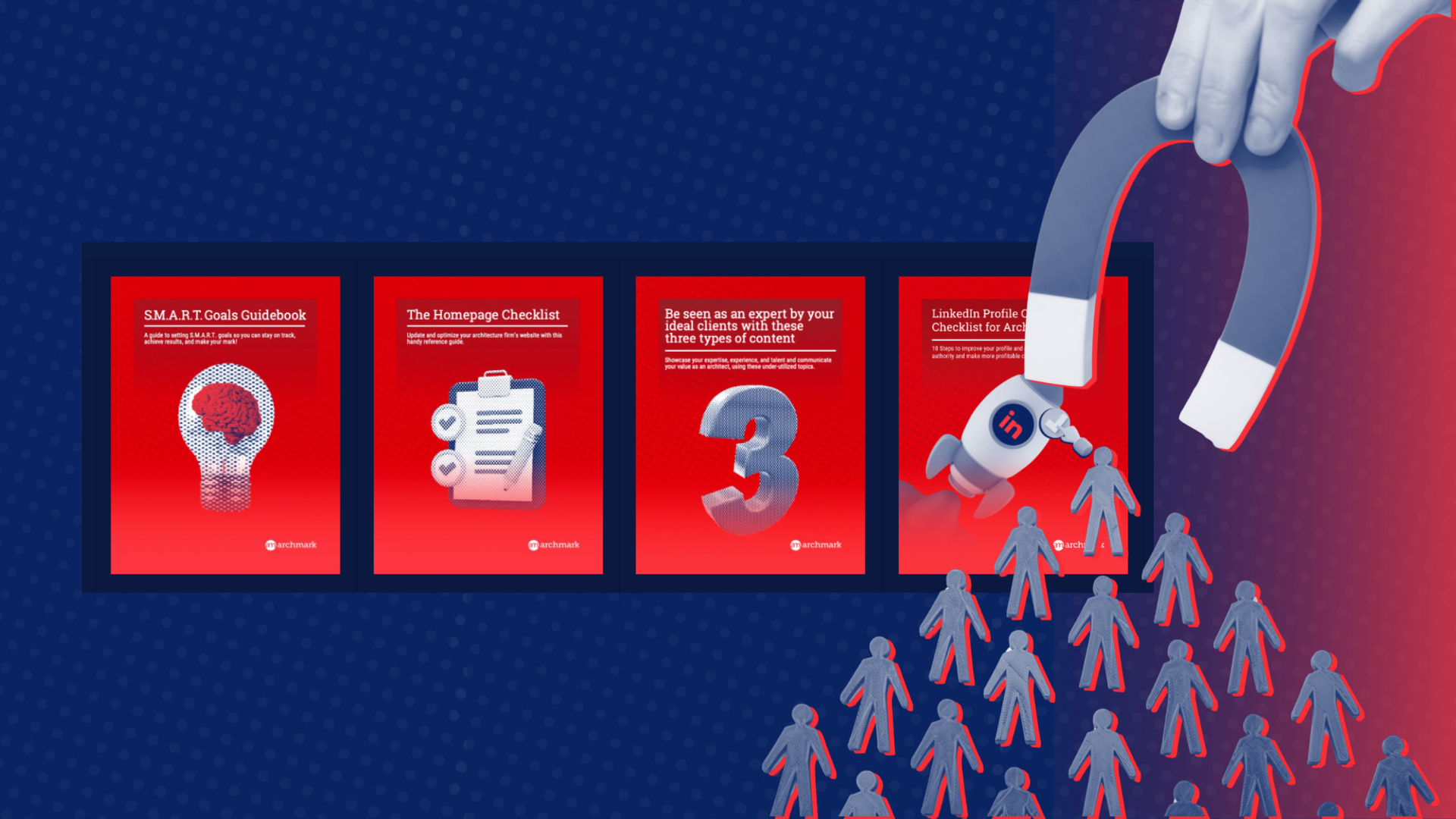Architecture Awards Matter, If You Tell the Right Story
How to Use Your Architecture Awards to Actually Win Projects
Picture this: You're at a cocktail party (remember those?) and someone asks what you do.
You say you're an architect.
Their eyes light up. "Oh wow, have you won any awards?"
You rattle off several accolades. AIA this. ALA that. Maybe throw in a Progressive Architecture Award for good measure.
Their eyes glaze over. "Oh, that's... nice."
And there it is.
The same reaction your website visitors have when they land on your architectural awards page. That polite, vague acknowledgment that means absolutely nothing for your business development.
You know what's worse than having no awards? Having a wall full of them that don't translate into any new projects no matter how much you believe those awards matter.
(And before you close this tab in frustration—stick with me. This isn't about bashing your achievements. It's about making them actually work for you.)
The Dirty Secret About Architecture Awards
Here's something nobody talks about at those AIA galas: Most clients don't know what your awards mean.
They don't know the difference between a Merit Award and an Honor Award. They definitely don't know what COTE stands for.
And they absolutely don't care about the nuanced design decisions that impressed the jury.
But here's what they do care about: Whether you can solve their specific, messy, complicated problem.
And buried in every single award you've ever won is evidence that you can. But, chances are good, you're just not telling that story.
After analyzing over 10,000 architecture websites (yes, really, we did that), we found that most firms list their architectural awards like the ingredients on a cereal box.
Just the facts. No context. No story. No connection to client value.
It's like having a Swiss Army knife and only ever using the tooth pick.
Why Your Brain Treats Awards Wrong (And It's Not Your Fault)
The Three-Second Test That Reveals Everything
Want to know if your awards are actually working for you? Try this:
Go to your website's awards section.
Set a timer for three seconds.
Start the timer and scan your awards page.
In those three seconds, could a potential client understand:
- What problem you solved?
- Why your solution was special?
- How this relates to their project?
If the answer is no (and let's be honest, it probably is), you're not using awards—you're just storing them in public.
That's roughly how long someone spends deciding if your awards page is worth reading or if they should jump to your portfolio. Or worse, to your competitor's site.

The "Trophy Case Syndrome" That's Costing You Projects
- Chronic Listing: The compulsive need to list every award in chronological order with no context or explanation.
- Acronym Fever: Using industry jargon that sounds impressive but means nothing to clients (LEED AP BD+C, anyone?).
- Humble Bragging Disorder: Mentioning awards without explaining their relevance, hoping clients will be impressed by quantity over quality.
- Context Deficiency: Failing to connect awards to actual client benefits or project outcomes. Say you showcase a lifetime achievement award — an incredible honor, but one that still needs context to show clients why it matters to them today.
What Your Awards Are Actually Trying to Tell Everyone

How to Make Your Architecture Awards Matter to Clients
- Will you actually listen to what I need, or force your vision on my project?
- Can you work within my constraints (budget, timeline, permit issues)?
- Will you make me look good to my board/community/stakeholders/family?
- Can I trust you to deliver what you promise?
- Will working with you be painful or pleasant?
The Psychology of Trust (And Why Awards Alone Don't Build It)

The Architects Getting It Right (And What They Do Differently)
- Problem-solving approach
- Value alignment
- Process transparency
- Client focus
- Measurable outcomes
The Uncomfortable Math of Award ROI
Let's talk numbers for a second. The average award submission costs:
- $500-2000 in entry fees
- 40-80 hours of staff time
- $2000-5000 in photography
- Countless hours of principal time
Total investment: $10,000-20,000 per award (conservatively).
If that award doesn't help you land at least one project, you've just funded a very expensive ego boost.
But here's the thing: Your awards COULD be generating that ROI. Easily.
The difference between an award that collects dust and one that generates leads isn't the quality of the project—it's the quality of the story you tell about it.
How to Perform Award CPR (Bringing Dead Awards Back to Life)
Your awards aren't dead. They're just in a coma. Here's how to revive them:
- Step 1: The Problem Diagnosis For each award, identify the core problem you solved. Not the design problem—the client problem. What kept them up at night? What were they worried about?
- Step 2: The Process Revelation What was your approach? Not the design process—the thinking process. How did you navigate constraints? How did you balance competing interests?
- Step 3: The Outcome Translation What happened as a result? Not "we won an award" but "the client saved X dollars" or "the community response was Y" or "the building performs Z% better than required."
- Step 4: The Award Contextualization Now, and only now, mention the award—as validation of the approach, not the main event.
- Step 5: The Connection Creation Explicitly connect this story to the problems your ideal clients face. Make it obvious why this matters to them.
The "So What?" Framework That Changes Everything
Here's a brutal editing technique that will transform how you talk about awards:
After every single statement about an award, ask "So what? Why should a client care?"
"We won a 2023 Design Excellence Award." So what?
"We won it for innovative use of mass timber construction." So what?
"This approach reduced construction time by 30%." So what?
"The client was able to open their facility a full quarter earlier than planned, capturing additional revenue and serving their community sooner."
Now we're talking.
Keep asking "So what?" until you hit something that would make a client's eyes light up. That's your story.
The Biggest Mistake Smart Firms Make
You know what kills me? The smartest firms often make the biggest mistake with their awards.
They assume clients will connect the dots themselves.
They think, "Surely people understand that winning a sustainability award means we can help them reduce operating costs."
No. They don't.
Your clients are not architects. They don't speak our language. They don't understand your values. They don't know what these awards mean.
And that's not their job. It's yours.
Every unexplained award on your website is a missed opportunity to demonstrate value. It's like having a supercar but never taking it to the track.
The Story Architecture of Award-Winning Marketing
Here's a simple structure for turning any award into a client-attracting story:
- The Setup: What situation did the client face? "Mercy Hospital needed to expand their cancer center but had no room to build out."
- The Challenge: What made this difficult? "The site was constrained by historic structures that couldn't be demolished and a community that was resistant to vertical expansion."
- The Insight: What did you realize that others missed? "We discovered that patients spent 70% of their time looking up from treatment chairs, making the ceiling the most important surface in the building."
- The Solution: What did you do differently? "We created a five-story expansion that appears as three from the street, with each treatment floor featuring a different ceiling installation that tells a story of hope through the seasons."
- The Result: What happened? "Patient satisfaction scores increased 35%, the community embraced the design, and the historic structures became integral to the healing journey rather than obstacles."
- The Recognition: Oh, and the award? "The healthcare design community recognized this approach with a 2023 Excellence Award, but the real recognition comes from the thank-you notes we still receive from patients."
Notice how the award is the punctuation, not the sentence?
Why This Matters More Than You Think
Look, I know what you're thinking. "This is a lot of work just to talk about some awards."
But here's the thing: This isn't really about awards. It's about differentiation.
In a world where every firm claims to be innovative, sustainable, and client-focused, your awards are one of the few pieces of third-party validation you have.
They're proof that you don't just talk the talk—you walk it so well that your peers applaud.
But that validation is worthless if clients don't understand what it validates.
The Future of Firms That Get This Right
The firms that figure this out—that learn to translate awards into client value—they're the ones who will thrive in the next decade.
Not because they'll win more awards.
But because they'll win more of the right projects. Projects that align with their values. Projects that showcase their strengths.
Projects that lead to more projects just like them, and better.
They'll build practices based on understanding, not just reputation.
They'll attract clients who hire them for their thinking, not just their portfolio.
And yes, they'll probably win more awards too. Because when you deeply understand client value, you tend to create projects that deliver it.
Your Next Move (If You're Serious About This)
Here's your homework, should you choose to accept it:
Pick your most recent award. Just one.
Now spend 15 minutes writing the real story behind it.
Not the design story—the human story. The client story. The problem-solving story.
Then ask yourself: If a potential client read this story, would they see themselves in it? Would they recognize their own challenges?
Would they believe you could help them?
If not, keep digging. The story is there. You lived it.
You just need to remember that the hero of the story isn't the building—it's the problem you solved.
The Bottom Line (Because Architecture Needs More Bottom Lines)
Your awards are not the problem. The way you talk about them is.
Every award you've ever won is a doorway to a conversation about value, process, and problem-solving.
But if you're treating them like trophies instead of tools, you're leaving money—and meaning—on the table.
Your clients don't need award-winning architects. They need problem-solving partners who happen to be recognized for excellence.
Show them that. Prove it through stories. Use your awards as evidence, not entertainment.
Because at the end of the day, your awards should work as hard as you do. And right now, they're just not pulling their weight.
Time to change that.
Ready to turn those dusty awards into business development tools that actually work?
Tired of watching competitors with half your credentials land projects you should have won?
Let's talk about how to make your achievements actually achieve something. Book a free Clarity Call and let's get your awards off the shelf and into your sales process.
Frequently Asked Questions (FAQ)
Do architecture awards really help win clients?
Only if you frame them around the problems you solved and the outcomes you achieved. Without context, awards are just noise to most clients. But when used strategically, they become powerful proof of your problem-solving skills.
Why don’t clients care about my architecture awards?
Most clients don’t understand what your awards mean or why they matter. They care about results: budgets, timelines, politics, and outcomes. If your awards don’t speak to those concerns, they’re not helping.
How can I make my awards meaningful to prospective clients?
Translate each award into a story. What challenge did the client face? What was your solution? What was the measurable result? Then connect that back to the award as third-party validation—not the headline.
Should I stop submitting to architecture award programs?
Not necessarily. But if you're investing time and money into awards, make sure you're also investing effort into telling the right story behind them. Awards should support your marketing, not just your ego.
What’s the biggest mistake firms make with their awards?
They assume clients will connect the dots on their own. But it's your job to make the relevance of your awards crystal clear. Otherwise, you're just listing trophies instead of using them as tools.
Stop letting your achievements gather dust. Book a free Clarity Call today and learn how to turn your architecture awards into powerful tools for winning your next project.











